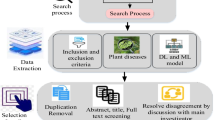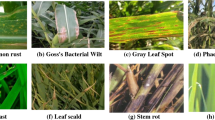Abstract
Plant disease diagnosis is one of the latest critical research areas of sustainable agriculture. The evolution of computer vision-based systems in order to identify, classify and localize diseases has automated the process of plant disease identification. CNNs are the pre-eminent deep learning-based algorithms used to automate plant disease recognition that has proven decisive on various benchmarks. However, a substantial part of the research lacks adequate attention to specific issues like the unavailability of datasets, high annotation costs and non-conformity of the models. Therefore, there is a pressing need to exploit the latest trends and technologies in this area to solve the above-mentioned problems. As a step ahead in this direction, a new framework has been proposed using semi-supervised & ensemble learning. The proposed framework is validated through a series of experiments on benchmark datasets. The results reported a significant performance improvement in classifying plant diseases, outperforming existing works with an improvement of 18.03% and 15% regarding the accuracy and F1 score, respectively. The mean average precision for detection is improved by 13.35%. Findings from this research will be beneficial for farmers, plant pathologists and researchers, which in turn will strengthen the sustainable facet of agriculture.

















Similar content being viewed by others
Data availability
The author confirms that all data generated or analysed during this study are included in below mentioned published articles. 1. https://doi.org/10.3389/fpls.2016.01419. 2. https://doi.org/10.1145/3371158.3371196. 3. https://doi.org/10.3390/agronomy11112107
Change history
29 November 2023
A Correction to this paper has been published: https://doi.org/10.1007/s41348-023-00829-2
References
Abade A, de Almeida A, Vidal F (2019) Plant diseases recognition from digital images using multichannel Convolutional Neural Networks. In: Proceedings of the 14th international joint conference on computer vision, imaging and computer graphics theory and applications. https://doi.org/10.5220/0007383904500458
Ahmad M, Abdullah M, Moon H, Han D (2021) Plant disease detection in imbalanced datasets using efficient convolutional neural networks with stepwise transfer learning. IEEE Access 9:140565–140580. https://doi.org/10.1109/access.2021.3119655
Alruwaili M, El-Ghany SA, Shehab A (2019) An enhanced plant disease classifier model based on Deep Learning Techniques. Int J Eng Adv Technol 9:7159–7164. https://doi.org/10.35940/ijeat.a1907.109119
Argüeso D, Picon A, Irusta U et al (2020) Few-shot learning approach for plant disease classification using images taken in the field. Comput Electr Agric 175:105542. https://doi.org/10.1016/j.compag.2020.105542
Arunnehru J, Vidhyasagar BS, Anwar Basha H (2020) Plant leaf diseases recognition using convolutional neural network and transfer learning. Lecture Notes in Electrical Engineering, pp 221–229. https://doi.org/10.1007/978-981-15-2612-1_21
Atila Ü, Uçar M, Akyol K, Uçar E (2021) Plant Leaf disease classification using EfficientNet Deep Learning Model. Ecol Inform 61:101182. https://doi.org/10.1016/j.ecoinf.2020.101182
Barbedo JGA (2018) Factors influencing the use of deep learning for plant disease recognition. Biosys Eng 172:84–91. https://doi.org/10.1016/j.biosystemseng.2018.05.013
Breiman L (2001) Random forests. Mach Learn 45:5–32. https://doi.org/10.1023/a:1010933404324
Chakraborty A, Kumer D, Deeba K (2021) Plant Leaf disease recognition using FASTAI image classification. In: 2021 5th International conference on computing methodologies and communication (ICCMC). https://doi.org/10.1109/iccmc51019.2021.9418042
Chen J, Chen J, Zhang D et al (2020) Using deep transfer learning for image-based plant disease identification. Comput Electr Agric 173:105393. https://doi.org/10.1016/j.compag.2020.105393
Chollet F (2017) Xception: deep learning with depthwise separable convolutions. In: 2017 IEEE conference on computer vision and pattern recognition (CVPR). https://doi.org/10.1109/cvpr.2017.195
DeChant C, Wiesner-Hanks T, Chen S et al (2017) Automated identification of northern leaf blight-infected maize plants from field imagery using Deep Learning. Phytopathology 107:1426–1432. https://doi.org/10.1094/phyto-11-16-0417-r
Fenu G, Malloci FM (2021) Diamos Plant: a dataset for diagnosis and monitoring plant disease. Agronomy 11:2107. https://doi.org/10.3390/agronomy11112107
Garcia Arnal Barbedo J, Vieira Koenigkan L, Almeida Halfeld-Vieira B et al (2018) Annotated Plant Pathology databases for image-based detection and recognition of diseases. IEEE Lat Am Trans 16:1749–1757. https://doi.org/10.1109/tla.2018.8444395
Gehlot M, Gandhi GC (2023) “effinet-ts”: a deep interpretable architecture using EfficientNet for plant disease detection and visualization. J Plant Dis Prot 130:413–430. https://doi.org/10.1007/s41348-023-00707-x
Goyal L, Sharma CM, Singh A, Singh PK (2021) Leaf and spike wheat disease detection & classification using an improved deep convolutional architecture. Inform Med Unlocked 25:100642. https://doi.org/10.1016/j.imu.2021.100642
Gutta S (2021) Object detection algorithm - YOLO V5 architecture. In: Medium. https://medium.com/analytics-vidhya/object-detection-algorithm-yolo-v5-architecture-89e0a35472ef
Hanh BT, Van Manh H, Nguyen N-V (2022) Enhancing the performance of transferred efficientnet models in leaf image-based plant disease classification. J Plant Dis Prot 129:623–634. https://doi.org/10.1007/s41348-022-00601-y
He K, Zhang X, Ren S, Sun J (2016) Deep residual learning for image recognition. In: 2016 IEEE conference on computer vision and pattern recognition (CVPR). https://doi.org/10.1109/cvpr.2016.90
Himani H (2014) An analysis of agriculture sector in Indian economy. IOSR J Human Soc Sci 19:47–54. https://doi.org/10.9790/0837-191104754
Hussain M, Bird JJ, Faria DR (2018) A study on CNN transfer learning for image classification. Adv Intell Syst Comput. https://doi.org/10.1007/978-3-319-97982-3_16
Indolia S, Goswami AK, Mishra SP, Asopa P (2018) Conceptual understanding of convolutional neural network- a deep learning approach. Procedia Comput Sci 132:679–688. https://doi.org/10.1016/j.procs.2018.05.069
Krizhevsky A, Sutskever I, Hinton GE (2012) NIPS'12: proceedings of the 25th international conference on neural information processing systems - Volume 1. In: ImageNet classification with deep convolutional neural networks. pp 1097–1105
Lee SH, Goëau H, Bonnet P, Joly A (2020) New perspectives on plant disease characterization based on deep learning. Comput Electron Agric 170:105220. https://doi.org/10.1016/j.compag.2020.105220
Li Y, Chao X (2021) Semi-supervised few-shot learning approach for plant diseases recognition. Plant Methods. https://doi.org/10.1186/s13007-021-00770-1
Lin T-Y, Maire M, Belongie S, et al (2014) Microsoft Coco: common objects in context. Computer Vision – ECCV 2014 740–755. https://doi.org/10.1007/978-3-319-10602-1_48
Liu X, Min W, Mei S et al (2021) Plant disease recognition: a large-scale benchmark dataset and a visual region and loss reweighting approach. IEEE Trans Image Process 30:2003–2015. https://doi.org/10.1109/tip.2021.3049334
Mahlein A-K, Heim RH-J, Brugger A et al (2022) Special issue: digital plant pathology for precision agriculture. J Plant Dis Prot 129:455–456. https://doi.org/10.1007/s41348-022-00620-9
Mohanty SP, Hughes DP, Salathé M (2016) Using deep learning for image-based plant disease detection. Front Plant Sci. https://doi.org/10.3389/fpls.2016.01419
Mukti IZ, Biswas D (2019) Transfer learning-based plant diseases detection using RESNET50. In: 2019 4th international conference on electrical information and communication technology (EICT). https://doi.org/10.1109/eict48899.2019.9068805
New standards to curb the global spread of plant pests and diseases (2019). In: FAO. https://www.fao.org/news/story/en/item/1187738/icode/
Nie X, Wang L, Ding H, Xu M (2019) Strawberry Verticillium wilt detection network based on multi-task learning and attention. IEEE Access 7:170003–170011. https://doi.org/10.1109/access.2019.2954845
Ouali Y, Hudelot C, Tami M (2006) An overview of deep semi-supervised learning. arXiv preprint arXiv:2006.05278
Pradhan P, Kumar B, Mohan S (2022) Comparison of various deep convolutional neural network models to discriminate Apple leaf diseases using transfer learning. J Plant Dis Prot 129:1461–1473. https://doi.org/10.1007/s41348-022-00660-1
Rahman CR, Arko PS, Ali ME et al (2020) Identification and recognition of rice diseases and pests using convolutional neural networks. Biosys Eng 194:112–120. https://doi.org/10.1016/j.biosystemseng.2020.03.020
Rawat W, Wang Z (2017) Deep convolutional neural networks for Image Classification: a comprehensive review. Neural Comput 29:2352–2449. https://doi.org/10.1162/neco_a_00990
Saleem MH, Potgieter J, Arif KM (2020) Plant disease classification: a comparative evaluation of convolutional neural networks and deep learning optimizers. Plants 9:1319. https://doi.org/10.3390/plants9101319
Samin OB, Omar M, Mansoor M (2021) Capplant: a capsule network based framework for plant disease classification. PeerJ Comput Sci. https://doi.org/10.7717/peerj-cs.752
Sandler M, Howard A, Zhu M, et al (2018) MobileNetV2: inverted residuals and linear bottlenecks. In: 2018 IEEE/CVF conference on computer vision and pattern recognition. https://doi.org/10.1109/cvpr.2018.00474
Sarker IH (2021a) Deep learning: a comprehensive overview on techniques, taxonomy, applications and Research Directions. SN Comput Sci. https://doi.org/10.1007/s42979-021-00815-1
Sarker IH (2021b) Machine learning: algorithms, real-world applications and research directions. SN Comput Sci. https://doi.org/10.1007/s42979-021-00592-x
Simonyan K, Zisserman A (2014) Very Deep Convolutional Networks for Large-Scale Image Recognition. Computer Vision and Pattern Recognition. arXiv preprint arXiv:14091556
Singh D, Jain N, Jain P, et al (2020) Plantdoc. In: Proceedings of the 7th ACM IKDD CoDS and 25th COMAD. https://doi.org/10.1145/3371158.3371196
Srinivasa Rao D, Babu ChR, Sravan Kiran V et al (2022) Plant disease classification using deep bilinear CNN. Intell Autom Soft Comput 31:161–176. https://doi.org/10.32604/iasc.2022.017706
Sun Y, Liu Y, Zhou H, Hu H (2021) Plant diseases identification through a discount momentum optimizer in deep learning. Appl Sci 11:9468. https://doi.org/10.3390/app11209468
Szegedy C, Ioffe S, Vanhoucke V, Alemi A (2017) Inception-V4, inception-resnet and the impact of residual connections on learning. In: Proceedings of the AAAI conference on artificial intelligence. https://doi.org/10.1609/aaai.v31i1.11231
Szegedy C, Vanhoucke V, Ioffe S, et al (2016) Rethinking the inception architecture for computer vision. In: 2016 IEEE conference on computer vision and pattern recognition (CVPR). https://doi.org/10.1109/cvpr.2016.308
Szegedy C, Wei Liu, Jia Y et al (2015) Going deeper with convolutions. In: 2015 IEEE conference on computer vision and pattern recognition (CVPR). https://doi.org/10.1109/cvpr.2015.7298594
Thapa R, Zhang K, Snavely N et al (2020) The Plant Pathology Challenge 2020 data set to classify foliar disease of apples. Appl Plant Sci. https://doi.org/10.1002/aps3.11390
Turkoglu M, Yanikoğlu B, Hanbay D (2021) PlantDiseaseNet: convolutional neural network ensemble for plant disease and pest detection. SIViP 16:301–309. https://doi.org/10.1007/s11760-021-01909-2
Wang T, Xu H, Hai Y et al (2022) An improved crop disease identification method based on lightweight convolutional neural network. J Electr Comput Eng 2022:1–16. https://doi.org/10.1155/2022/6342357
Zeng W, Li M (2020) Crop Leaf disease recognition based on self-attention convolutional neural network. Comput Electr Agric 172:105341. https://doi.org/10.1016/j.compag.2020.105341
Zhang Y, Wa S, Zhang L, Lv C (2022) Automatic plant disease detection based on tranvolution detection network with gan modules using leaf images. Front Plant Sci. https://doi.org/10.3389/fpls.2022.875693
Funding
The author(s) received no financial support for the research, authorship and/or publication of this article.
Author information
Authors and Affiliations
Corresponding author
Ethics declarations
Conflict of interest
The authors declare that they have no conflict of interest.
Ethical approval
This research did not contain any studies involving animal or human participants, nor did it take place on any private or protected areas.
Additional information
Publisher's Note
Springer Nature remains neutral with regard to jurisdictional claims in published maps and institutional affiliations.
The original online version of this article was revised due to correction in Table 9 and change in ORCID ID for Parul Sharma.
Rights and permissions
Springer Nature or its licensor (e.g. a society or other partner) holds exclusive rights to this article under a publishing agreement with the author(s) or other rightsholder(s); author self-archiving of the accepted manuscript version of this article is solely governed by the terms of such publishing agreement and applicable law.
About this article
Cite this article
Sharma, P., Sharma, A. A novel plant disease diagnosis framework by integrating semi-supervised and ensemble learning. J Plant Dis Prot 131, 177–198 (2024). https://doi.org/10.1007/s41348-023-00803-y
Received:
Accepted:
Published:
Issue Date:
DOI: https://doi.org/10.1007/s41348-023-00803-y




